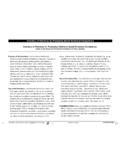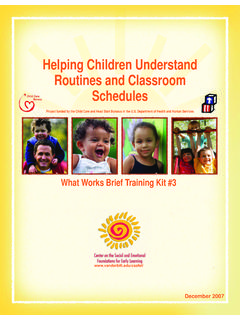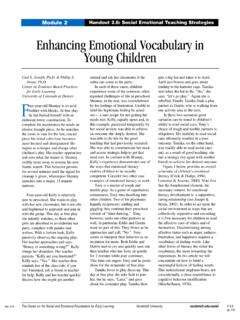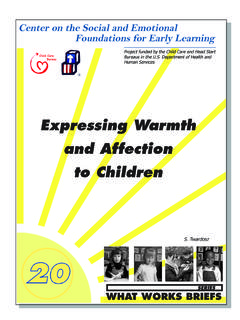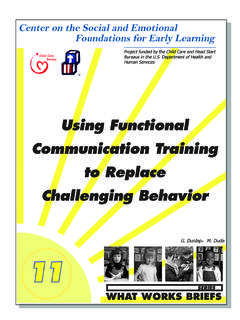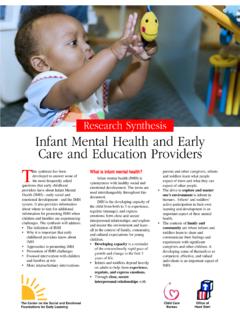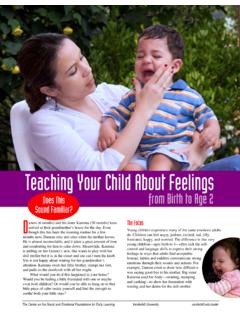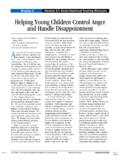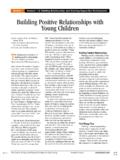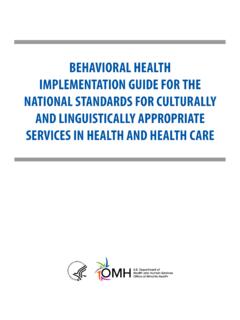Transcription of Building Positive Teacher-Child Relationships
1 Center on the Social and Emotional Foundations for Early Learning Project funded by the Child Care and Head Start Bureaus in the Department of Health and Human Services Building Positive Teacher-Child Relationships Ostrosky Jung SERIES. WHAT WORKS BRIEFS. Building Positive teacher - Child Relationships This What Works Brief is part of a continuing series caregivers support young children's social and of short, easy-to-read, how to information emotional development. They include examples and packets on a variety of evidence-based practices, vignettes that illustrate how practical strategies strategies, and intervention procedures. The Briefs might be used in a variety of early childhood are designed to help teachers, parents, and other settings and home environments. them through warm, responsive, physical contact such as giving W hile busy greeting children and preparing for the day, the teachers heard Alan, a 4-year boy, crying in the hallway.
2 Every morning, Alan cried very loudly and refused pats on the back, hugging, and holding young children in their laps. For preschool children, teachers encourage mutual respect between children and adults by waiting until children finish to come into the classroom from the bus. Mrs. Hannon, the asking questions before answering them, and by encouraging lead teacher , found herself becoming very frustrated with children to listen when others speak. In addition, teachers' use of Alan, and she told him to come to the classroom without Positive guidance techniques ( , modeling and encouraging asking why he was upset. During circle time, Alan repeat- appropriate behavior, redirecting children to more acceptable edly kicked his feet on the carpet and did not pay attention activities, setting clear limits) helps children develop trusting as Mrs. Hannon read a story to the group. Mrs. Hannon Relationships with their teachers.
3 Told Alan to stop kicking, but he continued kicking his feet in the air. Exasperated, Mrs. Hannon snapped at Alan, Stop kicking, I have had enough. You are going to leave circle It is important for teachers to use developmentally time. Go over there and sit on the chair. I am going to tell and individually appropriate strategies that take into your mom about this. As Alan moved to the thinking chair, he began to cry. He was very mad at Mrs. Hannon and consideration children's differing needs, interests, wished someone would snuggle him instead of yell at styles, and abilities. him. In developing Positive Teacher-Child Relationships , it is important What Are Positive Teacher-Child to remember to: Relationships ? In early childhood settings, each moment that teachers and 9 Engage in one-to-one interactions with children children interact with one another is an opportunity to develop 9 Get on the child's level for face-to-face interactions Positive Relationships .
4 Teachers can use a variety of strategies to 9 Use a pleasant, calm voice and simple language build Positive Relationships with children. teacher behaviors such as listening to children, making eye contact with them, and 9 Provide warm, responsive physical contact engaging in many one-to-one, face-to-face interactions with 9 Follow the child's lead and interest during play young children promote secure Teacher-Child Relationships . 9 Help children understand classroom expectations Talking to children using pleasant, calm voices and simple 9 Redirect children when they engage in challenging language, and greeting children warmly when they arrive in the behavior classroom with their parents or from the buses help establish 9 Listen to children and encourage them to listen to secure Relationships between teachers and children. others 9 Acknowledge children for their accomplishments and In early childhood settings, each moment that teachers effort and children interact with one another is an opportunity to develop Positive Relationships .
5 Given the above information, if we revisit our hypothetical early childhood classroom, we might observe the following scenario: It is important for teachers to use developmentally and individu- ally appropriate strategies that take into consideration children's During center time, Mrs. Hannon heard Alan crying, while differing needs, interests, styles, and abilities. For example, with she was helping another child with an art project. Mrs. infants and toddlers, teachers respond to their cries or other Hannon, realizing that she was again feeling very frustrated signs of distress. Teachers let children know they care about with Alan, decided that she needed to develop some new challenging behaviors and higher levels of competence in strategies when interacting with him. The next day, when Mrs. Hannon heard Alan coming toward the classroom, school. she went out into the hallway and bent down to his level, greeting him warmly and smiling at him.
6 As Alan entered Research has suggested that Teacher-Child the classroom holding Mrs. Hannon's hand, he did not cry; Relationships play a significant role in influencing he even smiled. During circle time, Alan listened to Mrs. young children's social and emotional development. Hannon read The Very Quiet Cricket, and he responded when she had the class rub their wings together by flapping their arms up and down in response to the book's Who Are the Children Who Have repeated phrase Nothing happened, not a sound. At the end of the day as she considered all that had happened, Participated in Research on teacher - Mrs. Hannon was pleased with how well the day went for Child Relationships ? Alan. She decided to look for resources on developing Research on Teacher-Child Relationships has been conducted Positive Relationships with young children. She found that with children from culturally diverse families in child care affectionate behaviors (such as smiles, pats, and hugs), a settings, university preschools, family child care settings, calm voice, and truly listening to young children help build Head Start programs, and kindergarten classrooms.
7 Partici- Positive Relationships between teachers and children. She pants have included children from European American, realized that she was often so busy managing the group of African American, Hispanic, and Asian American families. children that she missed the individual interactions with However, no studies indicated whether children with disabili- them. The next day, when Mrs. Hannon saw her students ties were included. When developing Relationships with coming down the hall to enter her classroom, she stopped young children, teachers should pay attention to the cultural , talking with her assistant teacher so she could greet each linguistic , and individual needs of the children. The impor- child with a warm smile and welcome. During circle time, tance of adapting strategies to meet the unique needs of the instead of giving attention to children who were not children and families in a teacher 's care cannot be overstated.
8 Listening, Mrs. Hannon praised children who were listen- ing and engaged in story time. Also, when Ms. Gloria, the teaching assistant, did some finger plays with the children, Where Do I Find More Information on Mrs. Hannon sat next to Alan. After the finger plays, Mrs. Implementing This Practice? Hannon gave Alan a high five and told him what a great job he did following along with the finger plays. The tone See the CSEFEL Web site ( ) for additional in the classroom felt more Positive , and Mrs. Hannon felt resources. she was using her energy to help children become engaged in classroom activities and enjoy their time in the class- Practical information on Teacher-Child relationship can be found room rather than using her energy to constantly nag and in journals such as Young Children. See the following articles attend to challenging behaviors. and books for examples of how to develop Positive teacher - child Relationships : Why Are Positive Teacher-Child Bredekamp, S.
9 , & Copple, C. (Eds.). (1997). Developmentally Relationships Important? appropriate practice in early childhood programs (Rev Research has suggested that Teacher-Child Relationships play a ed.). Washington, DC: National Association for the significant role in influencing young children's social and Education of Young Children. emotional development. In studies of Teacher-Child Relationships , children who had a secure relationship with their preschool and Center on the Social and Emotional Foundations for Early kindergarten teachers demonstrated good peer interactions and Learning. (2003). Promoting the social-emotional compe- Positive Relationships with teachers and peers in elementary tence of children. Training modules [Online]. Champaign, school. On the other hand, children who had insecure relation- IL: Author. Available: ships with teachers had more difficulty interacting with peers [2003, August 12]. and engaged in more conflict with their teachers.
10 In addition, research has shown that teachers' interaction styles with children Elicker, J., & Fortner-Wood, C. (1995). Adult-child Relationships help children build Positive and emotionally secure Relationships in early childhood programs. Young Children, 51(1), 69-78. with adults. For instance, teachers' smiling behaviors, affection- ate words, and appropriate physical contact help promote Kontos, S., Howes, C., Shinn, M., & Galinsky, E. (1995). children's Positive responses toward teachers. Also, children Quality in family child care and relative care. New York: whose teachers showed warmth and respect toward them ( , Teachers College Press. teachers who listened when children talked to them, made eye contact, treated children fairly) developed Positive and compe- Kontos, S., & Wilcox-Herzog, A. (1997). Teachers' interactions tent peer Relationships . Moreover, children who had secure with children: Why are they so important?
